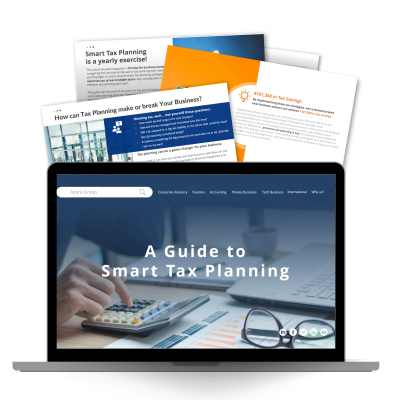Find out more about Strategic Tax Planning
Introduction
Strategic tax planning is the process of arranging your financial affairs in ways that reduce your tax liabilities while ensuring compliance with tax laws and regulations.
Effective tax planning can help you maximize savings, increase your financial health, and achieve your long-term financial goals. This page will guide you through the essential aspects of strategic tax planning, offering insights and strategies for both individuals and businesses.
Why is Strategic Tax Planning Important?
- Maximises Savings: Effective tax planning helps in identifying opportunities to reduce taxable income and take advantage of deductions and credits.
- Enhances Financial Efficiency: Strategic tax planning can lead to better cash flow management and improved financial stability.
- Prevents Tax Liabilities: Proactive planning helps in avoiding unexpected tax liabilities and penalties.
- Supports Business Goals: For businesses, strategic tax planning aligns financial strategies with long-term objectives.
Fundamental Principles
Tax Law Compliance
Adhering to tax laws and regulations is crucial. Compliance not only avoids penalties and interest but also builds a solid foundation for effective tax planning.
Proactive Planning
Strategic tax planning is not a once-a-year activity. It requires a proactive approach throughout the year to identify opportunities and make informed decisions.
Tailored Strategies
No two tax situations are identical. Personalized tax planning strategies are necessary to address the unique financial circumstances of individuals and businesses.
Working with a credible and professional Tax Advisor
Working with a credible and professional tax advisor significantly reduces the likelihood of being audited. By engaging a reputable tax advisor, you not only enhance the accuracy and compliance of your tax filings but also gain peace of mind knowing that the likelihood of being audited is significantly reduced.
Key Tax Planning Strategies
Income Deferral and Shifting
Techniques to defer income or shift it to lower tax years or entities can reduce overall tax liabilities. This may include retirement accounts, trusts, and family partnerships.
Deductions and Credits
Maximising deductions and credits is a fundamental aspect of tax planning. Common deductions include mortgage interest, medical expenses, and business expenses.
Tax-Advantaged Investments
Investing in tax-advantaged strategies like negative gearing and growth assets can provide substantial benefits. Negative Gearing: Borrowing to purchase an income-producing asset where costs exceed income. The resulting loss can be offset against other income, reducing taxable income.
Estate Tax Planning
Estate planning techniques, including trusts and charitable contributions, help manage and minimise tax liabilities.
Tax Planning for Individuals
Personal Tax Strategies
Optimising your tax situation involves a variety of strategies, such as contributing to superannuation, negative gearing via property investment, and making charitable donations.
High-Net-Worth Individuals
For high-net-worth individuals, specialised strategies, including wealth transfer planning, investment in tax-efficient vehicles, and international tax planning, are crucial to managing tax liabilities effectively.
Tax Planning for Businesses
Business Structures
Choosing the right business structure (sole trader, partnership, company, trust, or SMSF) can significantly impact tax liabilities.
Expense Management
Effectively managing business expenses can maximise deductions, including tracking operational costs, employee benefits, and capital expenditures.
Tax Credits for Businesses
Businesses can benefit from various tax credits such as Research and Development (R&D) credits, energy efficiency incentives, and job creation credits.
Succession Planning
Succession planning ensures a smooth transition and minimizes tax impacts. This involves strategies like business valuation, buy-sell agreements, and estate planning.
DOWNLOAD GUIDE TO SMART TAX PLANNING
Find out more about smart planning tax strategies by downloading our guide to smart tax planing.
DOWNLOAD NOWThe importance of Tax Planning
Just as a conductor leads a symphony, a thoughtfully planned tax approach ensures a balanced harmony between profits and compliance, paving the way for long-term business success.
Why is Tax Planning Important?
- Minimise Tax Liability: Effective tax planning can reduce the amount of taxes your business owes.
- Optimise Cash Flow: Proper tax planning ensures that taxes are paid on time, avoiding penalties and interest.
- Ensure Tax Compliance: Staying compliant with tax laws helps avoid audits and legal issues.
- Support Business Goals: Tax planning aligns with broader business strategies, supporting growth and financial stability.
DOWNLOAD GUIDE TO SMART TAX PLANNING
Find out more about strategic tax planning by downloading our guide to smart tax planning.
DOWNLOAD NOWKey Components of Business Tax Planning
Business Structure Optimisation
Income and Expense Management
Investment Planning
Selecting investments that provide tax advantages, such as superannuation funds and tax-free bonds.
Tax Incentives and Credits
Identifying and utilising tax incentives and credits available for specific activities, such as R&D, energy efficiency, and small business concessions.
Succession and Estate Planning
Planning for the transfer of business ownership and wealth to minimise tax impact on successors.
International Tax Considerations
Managing tax obligations for businesses with international operations to optimise global tax efficiency.
The Benefits of Strategic Tax Planning
Effective tax planning can provide numerous advantages for businesses, helping them achieve financial efficiency and stability. Here are some key benefits of tax planning:
-
Reduced Tax Liability
By strategically planning and managing tax obligations, businesses can minimize the amount of taxes owed. This involves utilizing tax deductions, credits, and allowances available under Australian tax laws. -
Improved Cash Flow
Effective tax planning ensures that businesses can better manage their cash flow by forecasting tax liabilities and timing expenses and income appropriately. This allows for more predictable financial planning and stability. -
Enhanced Compliance
Staying compliant with Australian tax laws and regulations is crucial to avoid penalties, fines, and legal issues. Proper tax planning ensures that businesses meet all their tax obligations in a timely and accurate manner. -
Optimised Use of Tax Benefits
Tax planning helps businesses take full advantage of tax benefits such as deductions for business expenses, credits for research and development, and incentives for investing in certain areas like renewable energy. -
Financial Efficiency
Businesses can achieve greater financial efficiency by structuring transactions and investments in a tax-efficient manner. This can lead to lower overall costs and improved profitability. -
Strategic Investment Decisions
Tax planning enables businesses to make informed decisions about investments, taking into account the tax implications of various options. This can lead to more advantageous investment strategies and better returns. -
Better Business Decisions
With a clear understanding of tax implications, business owners can make better strategic decisions, such as choosing the right business structure, planning for expansions, and managing mergers and acquisitions. -
Risk Management
Proper tax planning helps identify and mitigate potential tax risks. By understanding tax obligations and planning accordingly, businesses can avoid unexpected tax liabilities and reduce the risk of audits. -
Long-Term Financial Planning
Tax planning is an integral part of long-term financial planning. It helps businesses prepare for future growth, expansions, and transitions, ensuring that they are financially sustainable in the long run. -
Enhanced Competitiveness
By optimizing tax liabilities and improving financial efficiency, businesses can reinvest the savings into growth and development, making them more competitive in their respective markets. -
Support for Business Goals
Aligning tax planning with business goals ensures that tax strategies support the overall objectives of the business, whether it’s expansion, innovation, or increased profitability. -
Succession and Estate Planning
Effective tax planning includes preparing for the future transition of business ownership and estate planning, which can minimize the tax impact on successors and ensure a smooth transition.
Downloadable Tax Planning resources
The Tax Planning downloadable resources contain information on a range of Tax Planning topics to help you understand the tax planning.
Downloadable Taxation Smart Tips
Talk to our Tax Team
Our team consists of more than 40 professionals, led by experienced Partners from both Big 4, Mid-Tier and boutique, chartered environments with over 100 years' experience. Our team are experts in supporting clients with effective Tax Planning Strategies and reviewing their tax affairs.
CONTACT USGet the latest Tax Planning insights and guidance
The R&D Tax Incentive articles contain information on a range of topics to help you understand the R&D program.
Tax Planning End of Financial Year 2024 Checklist for Businesses
The end of the financial year (EOFY) is an important time for businesses. It’s essential for businesses to start preparing to ensure a smooth transition and to maximise their tax benefits.
By following this checklist, you can ensure that your financial records are accurate, your tax obligations are met, and your business is in a strong position for the year ahead.
TAX PLANNING Smart Timing could Save You Money when Paying Bonuses to Employees
Employee bonuses serve as powerful motivators and rewards for hard work. However, when it comes to paying these bonuses, timing is more than just a logistical consideration — it's a strategic move that can impact both employees and employers. In Australia, understanding the nuances of tax regulations is crucial for making the most of your bonus payouts.
Learn moreSelf-Managed Superfund Beginners Guide to Self-Managed Superfunds (SMSFs)
Embarking on the journey of managing your own financial destiny through a Self-Managed Superfund (SMSF) is both empowering and rewarding. Whether you're navigating the world of superannuation for the first time or considering taking control of your retirement savings, this Beginner's Guide to SMSFs is your compass.
In this guide, we'll unravel the intricacies, offer insights, and provide a roadmap to help you confidently steer your SMSF toward a secure and prosperous future.
R&D Tax Incentive R&D: Should you just worry about record keeping at the end of the Financial Year?
For our final blog post for the R&D month, we focus on best practice record-keeping that ensures a successful R&D claim that will stand up to rigorous audit activity.
Learn moreStrategic Tax Planning Why Tax Planning Strategies are an Integral Part of Business Growth
For many businesses Tax Planning is a topic that comes to mind briefly when the annual tax return is being prepared and maybe again after it has been submitted. It is often a subject that business owners know they need to invest time in but is relegated down the ‘to-do' list as the day-to-day demands of running and growing a business seem to allow no extra time for anything else. However, by the time transactions have taken place or the end of the financial year rolls around, it is too late to begin Tax Planning.
As a society, we are currently wading through the next wave of the Industrial Revolution which will have far reaching impacts to how businesses and society as a whole operate in the future.
Fringe Benefits Tax Festive Celebrations at Work: Christmas Parties and Gifts with FBT in Mind
The holiday season is a time for joy, celebration, and giving. For businesses, it's also a time to navigate the complexities of Fringe Benefits Tax (FBT) when planning Christmas parties and giving gifts to employees. Understanding the implications of FBT can ensure that your festive generosity doesn't come with unexpected tax burdens.
Learn moreR&D Tax Incentive The Most Common Mistakes in R&D Tax Incentive Application and how to Avoid them
Research and Development (R&D) Tax Incentives are a fantastic way for businesses to recoup some of their costs associated with innovation and R&D. However, navigating the R&D Tax Incentive application process can be tricky, and many companies fall into common traps that hinder their chances of securing the deserved benefits.
Learn moreEstate Planning 9 Benefits of Having an Estate Plan
A disorganised estate can leave a major burden on your loved ones. Without a valid Estate Plan, assets may fall into the wrong hands or get tied up in the court system, and you may end up significantly reducing the value of the estate by paying far more than you need to in taxes and legal fees.
While no one likes to think about dying, it is important to plan ahead to protect your family when they need it most. If you do not yet have Estate Plan in place, this article will outline the benefits of establishing one and how a professional accountant can help reduce tax obligations for your beneficiaries.
Self-Managed Superfund Steps to Setting up Self-Managed Superfund (SMSF)
Setting up a Self-Managed Superannuation Fund (SMSF) is a significant financial decision that offers you greater control and flexibility over your retirement savings. While it provides opportunities for strategic investment and tailored financial planning, it also comes with important responsibilities and regulatory requirements.
Setting up a Self-Managed Superannuation Fund (SMSF) involves several steps. Below you can find a general guide, but keep in mind that seeking professional advice is crucial for your specific situation.
Self-Managed Superfund Why Accurate SMSF Record-Keeping is Super Important
Self-Managed Super Funds (SMSFs) offer individuals more control and flexibility over their retirement savings. However, with great power comes great responsibility, and one of the critical aspects of SMSF management is diligent record-keeping.
In this article, we will explore SMSF record-keeping requirements, the types of records that must be maintained, and for how long. Whether you are already managing an existing SMSF or looking for advice for setting up an SMSF, understanding these crucial aspects is paramount to ensuring compliance with the Australian Taxation Office (ATO) and maximising your retirement balance.ucture.
Fringe Benefits Tax Fringe Benefits Tax (FBT) Checklist
The Fringe Benefits Tax (FBT) year will come to an end on 31 March. If you have provided any fringe benefits to your employees during the year, your business may be liable for the fringe benefits tax.
Learn moreTax Preparation and Tax Planning Now is a Good Time to Start Tax Preparation and Year End Tax Planning
As we are quickly approaching the end of financial year, now is a good time to start tax preparation and have a look at both your expected taxable income for the current financial year and your projected taxable income for the next financial year as they will help guide your Tax Planning Strategy.
Have you ever heard the saying, ‘A stitch in time saves nine’? The same philosophy holds true for tax planning. It should be started as early as possible so that you are not in a rush at EOFY time.













